Description
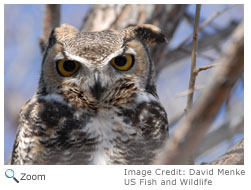 The great horned owl is probably best known for the large tufts of feathers on its head that look like horns. The great horned owl is probably best known for the large tufts of feathers on its head that look like horns.
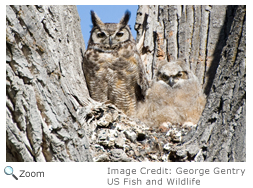 It has big, cat-like eyes and brown, white, gray, and black markings that look like the bark of a tree. These markings help camouflage it in the woods. It has a wing span of over four feet, and it is about two feet in height. It has big, cat-like eyes and brown, white, gray, and black markings that look like the bark of a tree. These markings help camouflage it in the woods. It has a wing span of over four feet, and it is about two feet in height.
Range 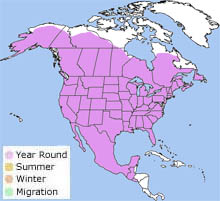 The great horned owl has a very large range. The great horned owl has a very large range.
It is found in forests throughout most of Canada, the United States, and Mexico.
It is also found in Central and South America. The great horned owl is found throughout New Hampshire. Habitat
The great horned owl lives in woodlands, along cliffs and canyons, and at the edge of forests.
|
|
Diet
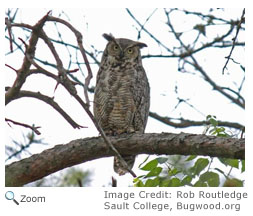 The great horned owl is nocturnal. It hunts small mammals like mice, rabbits, squirrels, and skunks. It also eats birds like ducks and quail. It eats small prey whole; it rips larger prey up into smaller pieces that it can swallow. It regurgitates or throws up the undigested parts, like bones and fur, in owl pellets. You can often tell what an owl has eaten by looking at these pellets. The great horned owl is nocturnal. It hunts small mammals like mice, rabbits, squirrels, and skunks. It also eats birds like ducks and quail. It eats small prey whole; it rips larger prey up into smaller pieces that it can swallow. It regurgitates or throws up the undigested parts, like bones and fur, in owl pellets. You can often tell what an owl has eaten by looking at these pellets.
Life Cycle
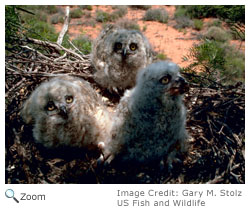 January and early February is mating time for the great horned owl. The male and female call to each other during courtship. They use the abandoned nests of other birds, usually hawks or crows. The female lays 2-3 eggs. She raises one family each year. Both the male and female incubate the eggs and provide food for the owlets. January and early February is mating time for the great horned owl. The male and female call to each other during courtship. They use the abandoned nests of other birds, usually hawks or crows. The female lays 2-3 eggs. She raises one family each year. Both the male and female incubate the eggs and provide food for the owlets.
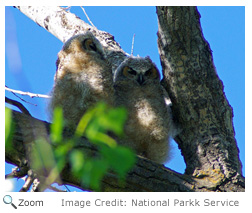 The eggs hatch in about four weeks. Great horned owls are very protective parents and attack intruders. The young owls leave the nest when they are between one and two months old and can fly when they are nine to ten weeks old. The eggs hatch in about four weeks. Great horned owls are very protective parents and attack intruders. The young owls leave the nest when they are between one and two months old and can fly when they are nine to ten weeks old.
Behavior
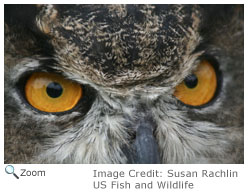 The great horned owl's excellent hearing and eyesight help it hunt at night. Its loosely-packed feathers make it almost silent when it flies. This makes it easier to sneak up on its prey. The great horned owl's excellent hearing and eyesight help it hunt at night. Its loosely-packed feathers make it almost silent when it flies. This makes it easier to sneak up on its prey.
|




 The great horned owl has a very large range.
The great horned owl has a very large range.


